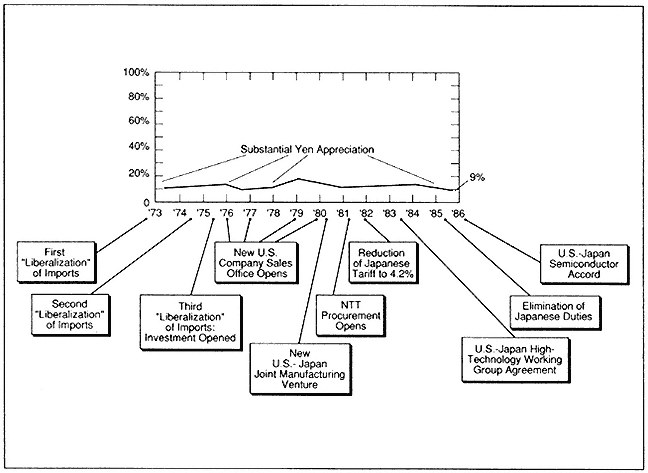Trade:
"Successful" Negotiations and "Potato Chips"
Another major difficulty for U.S. high-technology manufacturers is the asymmetry in U.S. and Japanese market accesses; U.S. markets are wide open through our ideology, whereas Japanese markets are not. The U.S. government, which historically has shunned "intervention," has been reluctant to "start a trade war" and insists that U.S. firms are better off standing alone. The government, whose policies might be stated as, "It doesn't matter if we export computer chips or potato chips,"[*] has been practicing what can only be called unilateral disarmament in international trade battles.
Law 3—
When Two Countries Are in a Trade War and One Does Not Realize It, That Country Is Unlikely to Win
The Japanese markets in target industries are, have been, and are likely to remain closed. In the U.S., we refer to such a phenomenon as "protectionism." This market was protected when the Japanese were behind. This market was protected while the Japanese caught up. This market remains protected even now after the Japanese have achieved substantial superiority in many of its products.
These facts violate conventional wisdom that equates protectionism with sloth. Clearly, that has not been the case for the Japanese. Protectionism for the Japanese can't be all bad; it is possible for protectionism to work to the benefit of a nation; it has for Japan. Today, the U.S. has a weekly trade deficit with Japan of about one billion dollars—almost half of which is spent on automobiles—which feeds into the Japanese R&D cycle rather than our own.
Protectionism has long been the name of the game for Japan, and the U.S. has an extremely poor track record in trade negotiations with the Japanese. There are general trade principles understood by both the U.S. and Japan, some of which are embodied in specific, written trade agreements. An important one is that each side should buy those technological
[*] The exact quote—"Potato chips, semiconductor chips, what's the difference? They are all chips."—was made by Michael Boskin, Chairman of the Council of Economic Advisors to the President.
products that the other side can produce more economically. The Japanese, however, routinely violate these principles whenever it is convenient to do so, and the U.S. does not pressure the Japanese to meet their obligations. Seventeen negotiations between the United States and Japan in semiconductors have been almost completely ineffectual. These general comments are illustrated in Figure 1, which is also known to the industry as the "worm chart."
Figure 1 shows the share of the Japanese semiconductor market held by U.S. producers over the period 1973–1986 in relation to a series of "successful" negotiations between the United States and Japan to open the Japanese semiconductor market to competition by U.S. firms. It is startling to note that the U.S. market share has dropped by approximately one per cent—from 10 to nine per cent—in the wake of these "successful" negotiations.
During the early period, Japanese firms were no match for their American rivals. By the early 1980s, they had caught up in many areas and were already ahead in some. By the end of the period, Japanese firms had established general superiority. Yet, throughout the entire period, and irrespective of the relative quality of the U.S. versus Japanese products,

Figure 1.
The Worm Chart: U.S. share of Japanese semiconductor market.
the U.S. market share has remained virtually the same. It could be characterized as a "worm," lying across the chart at the 10 per cent level.
There's something about the way the Japanese manage their economy that has led to a constant U.S. share of its semiconductor business in the range of approximately 10 per cent. Given the multitude of variables involved, it is a virtual impossibility that markets alone could have brought about such a result.